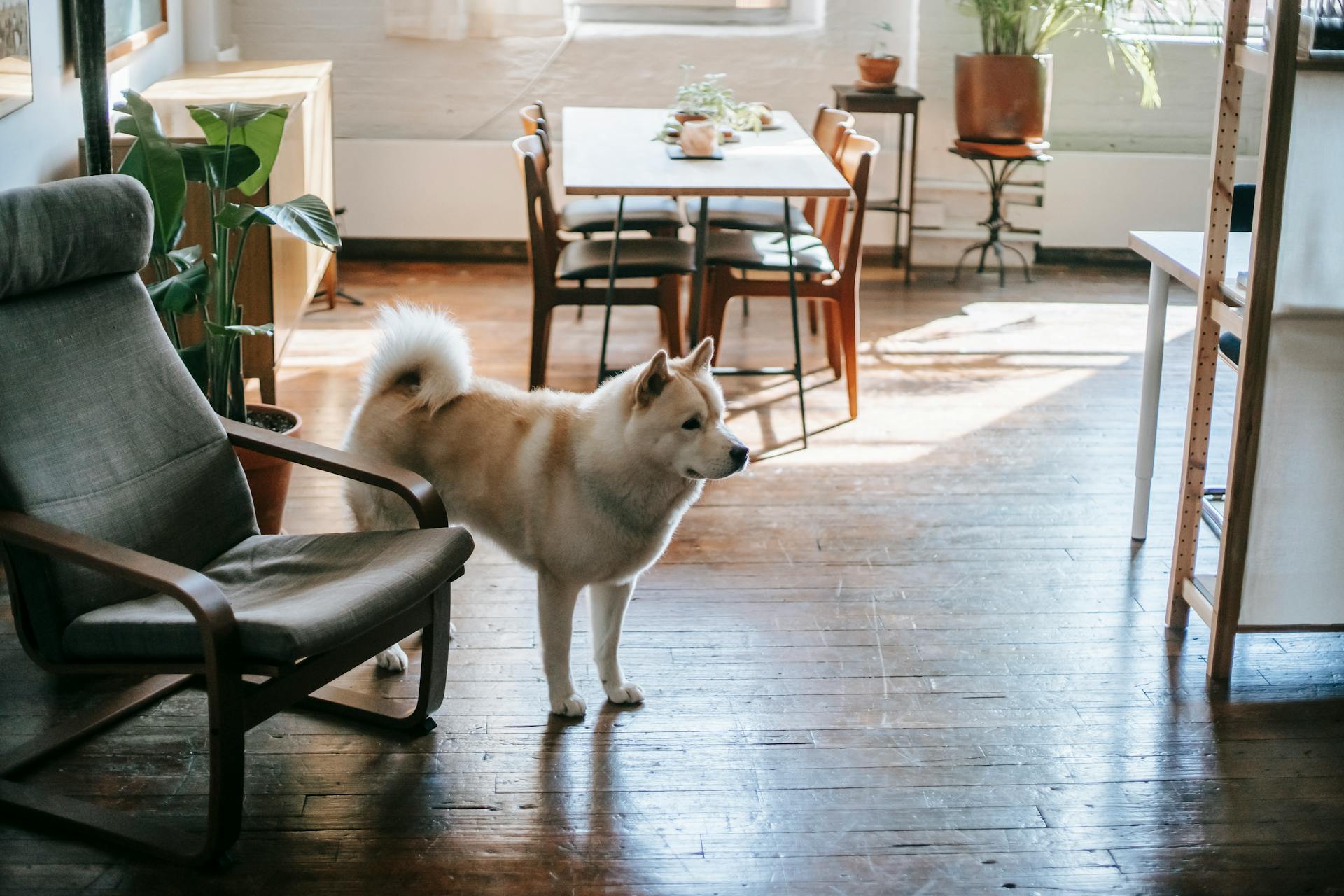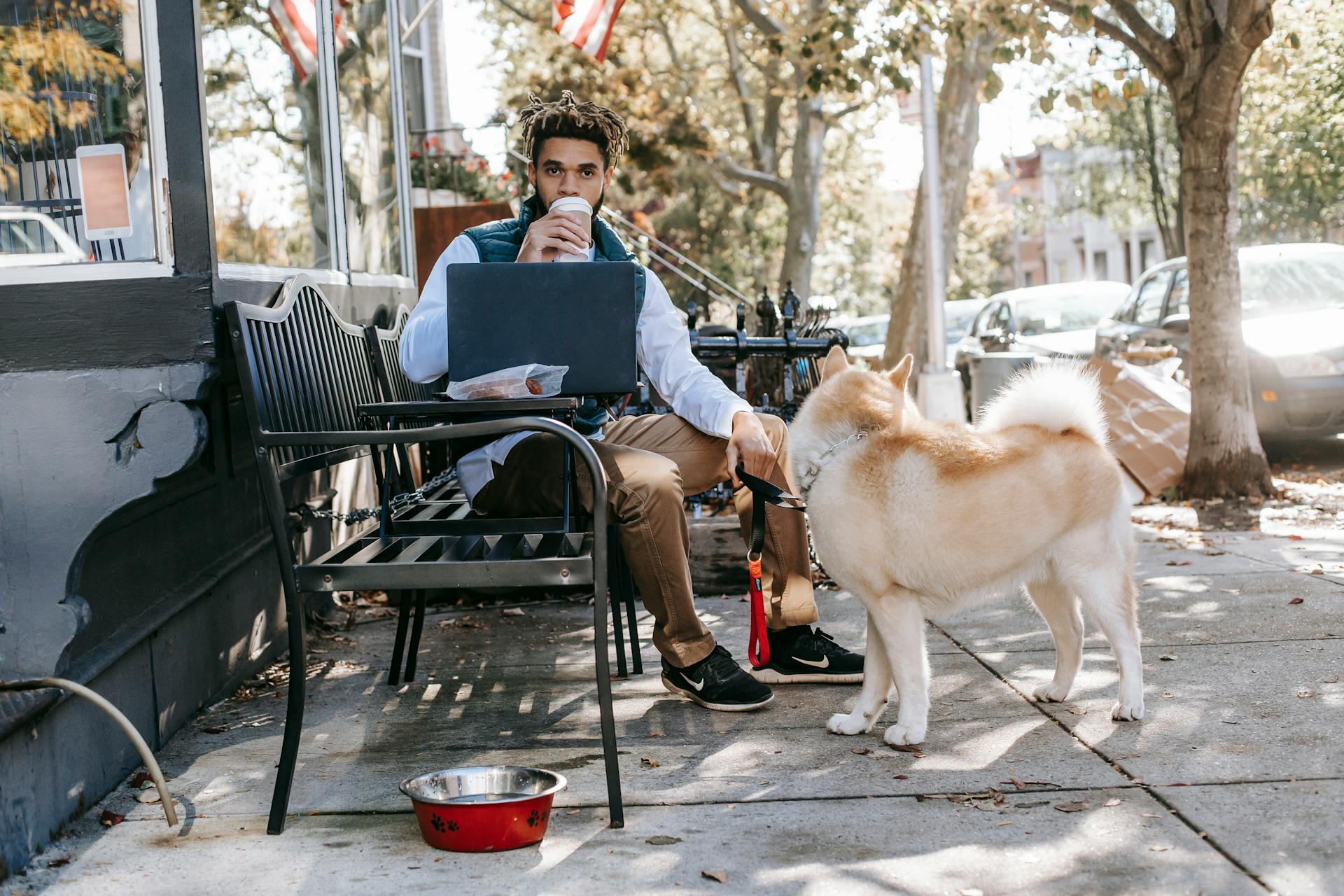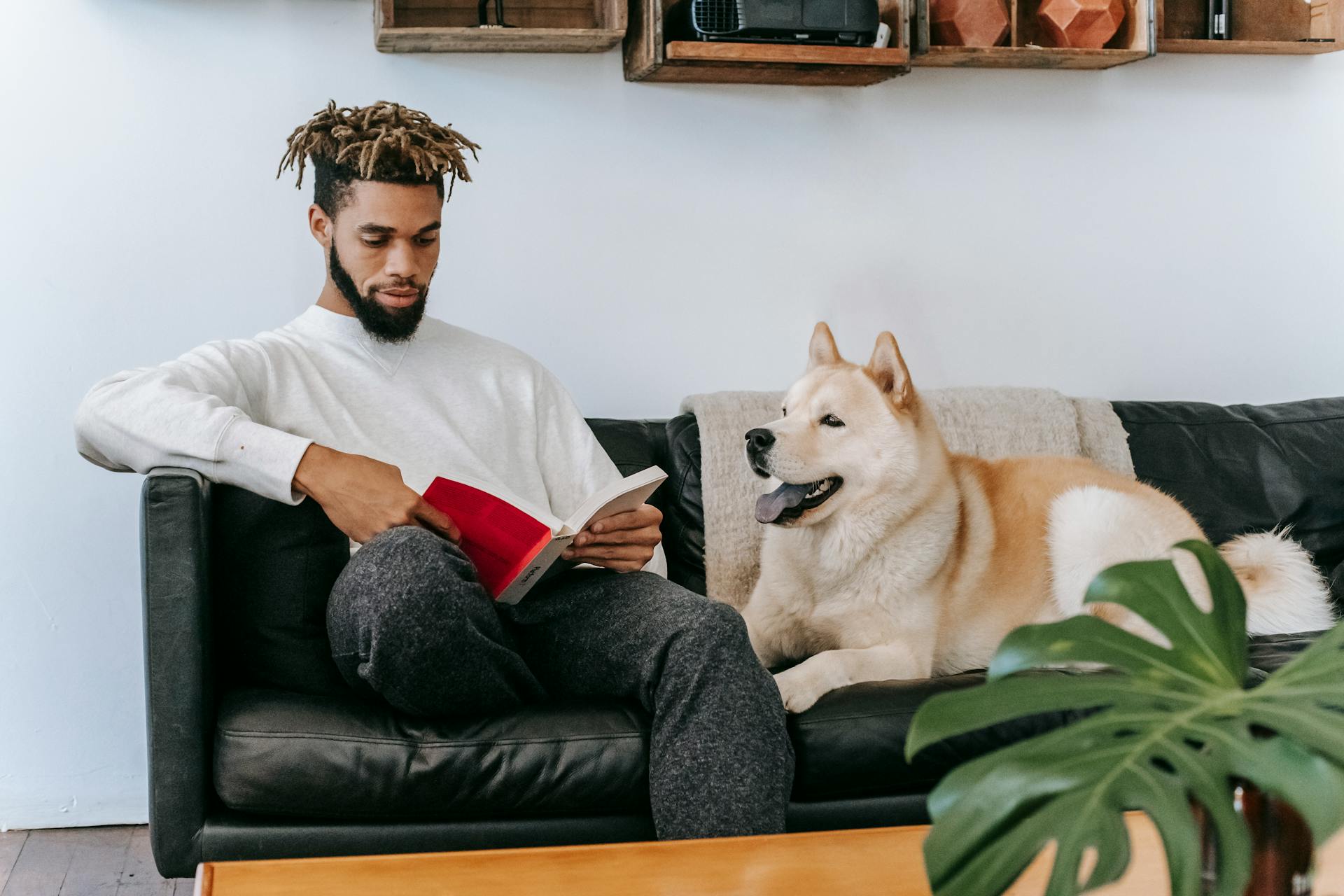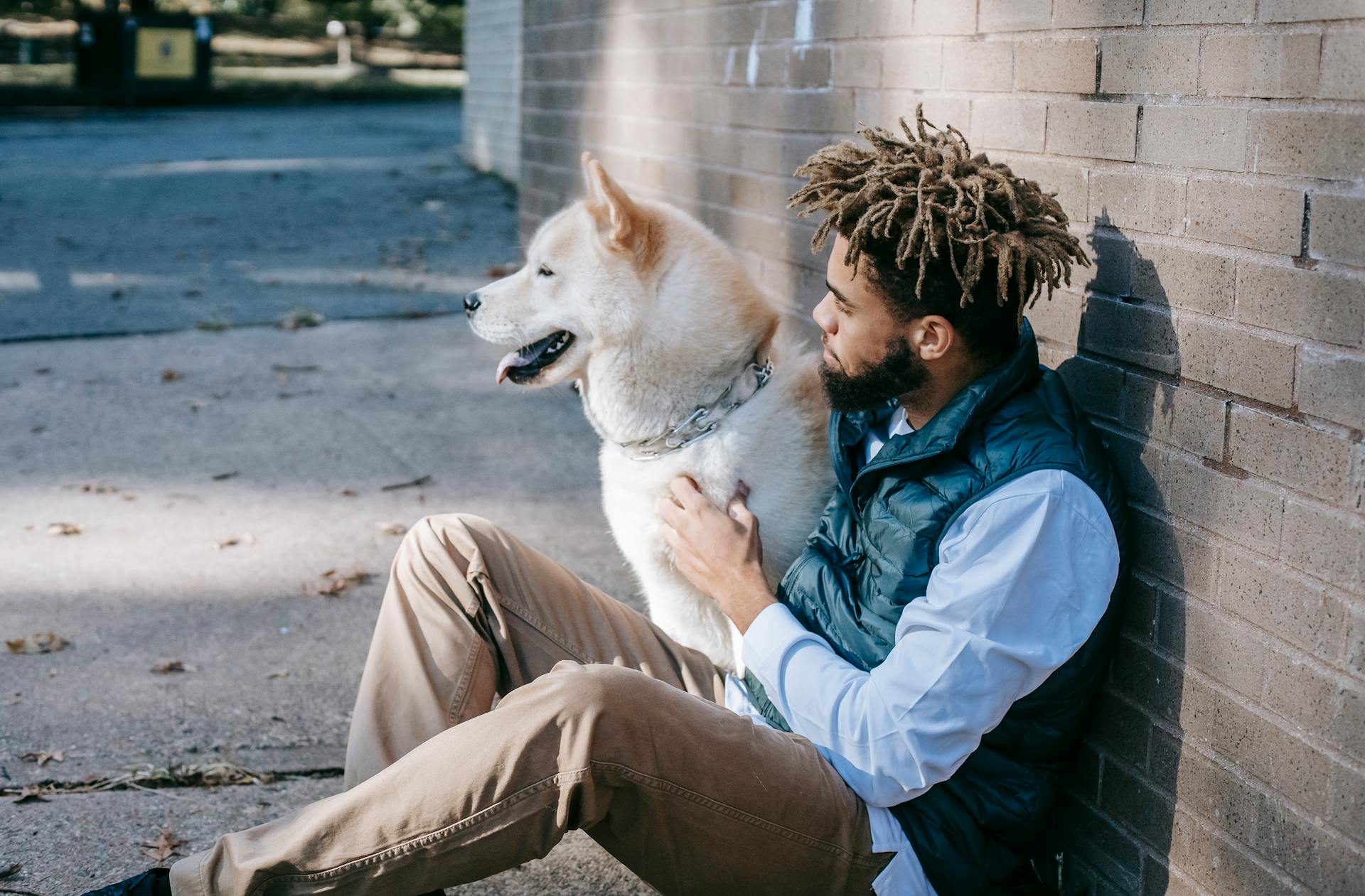
American Akita puppies are adorable bundles of energy and joy, but they require careful attention and care to grow into healthy, well-adjusted adult dogs.
At birth, American Akita puppies are blind and helpless, weighing around 1-2 pounds. They rely on their mother's milk and warmth for survival.
Their eyes and ears begin to open around 10-14 days old, and they start to develop their motor skills, like crawling and standing.
By 4-6 weeks, American Akita puppies are weaned and start to eat solid food, requiring a nutrient-rich diet to support their rapid growth.
American Akita Puppy Development
American Akita puppies develop rapidly, with significant weight gains as they grow. A healthy Akita can start at around 4-7 pounds at birth and by 3 months, they might weigh around 30-40 pounds.
During the neonatal period, from 0-2 weeks, puppies develop rapidly physically and sensorily, despite their initial helplessness. It's essential to keep the nesting area comfortably warm and maintain cleanliness to prevent infections.
As they enter the transitional period, from 2-4 weeks, puppies experience a miraculous transformation, with their eyes opening and ears functioning for the first time. This is also a great time to introduce puppy food, as they begin the weaning process.
Here's a breakdown of the key milestones during the first 4 weeks:
- Neonatal Period (0-2 Weeks): Rapid physical and sensory development, initial helplessness, and dependence on mother's care.
- Transitional Period (2-4 Weeks): Eyes and ears open, teething begins, and growth milestones are reached.
By actively engaging in your Akita puppy's socialization during the socialization period, from 4-12 weeks, you play a direct role in their development into a confident, serene, and well-mannered companion.
Neonatal 0-2 Weeks
During the neonatal period, your American Akita puppy will experience rapid physical and sensory development, despite their initial helplessness.
Keeping the nesting area comfortably warm is crucial, as the puppies can't regulate their temperature.
Maintaining cleanliness is essential to prevent infections not just for the puppies but also for the mother.
Regular feeding from the mother is vital, and if there's an issue, you may need to step in with bottle-feeding.
Regular check-ups from the vet are key to catch any early health concerns, and being in the loop with your vet is like having a lifeline.
Here's a breakdown of the care tips during the neonatal period:
- Warmth: Keep the nesting area comfortably warm.
- Hygiene: Maintain cleanliness to prevent infections.
- Feeding: Watch out for regular feeding from the mother, and be prepared to step in with bottle-feeding if needed.
- Health Checks: Regular check-ups from the vet are essential.
Transitional (2-4 Weeks)
At 2-4 weeks, your American Akita puppy is experiencing a miraculous transformation, going from a tiny, closed-eye bundle to a little explorer with all senses in gear.
Their eyes will transition from tightly shut to fully open, greeting the world with newfound sight. This is the first time they'll see their surroundings, so be prepared for a curious and wide-eyed puppy!
Teething begins, and those baby teeth start to emerge. It's a great time to introduce puppy food, as they're inching towards weaning off their mother's milk. Soft and easily digestible food is best, so make sure to choose a suitable option.
Akitas will experience significant growth even now, gaining strength to stand and tentatively take their first steps. This is an exciting time, and with the right care, your puppy will blossom into a confident and sociable adult dog.
A different take: Senior Dogs Eat Puppy Food
Here are some key milestones to look out for during this period:
- Eyes: Open and taking in their surroundings
- Ears: Picking up sounds and experiencing their first auditory experience
- Teeth: Emerging and starting to come in
- Growth: Significant growth, gaining strength to stand and walk
Remember, supporting your puppy through this period with the right care and attention paves the way for a well-rounded and sociable adult dog.
Socialization (4-12 Weeks)
The socialization period for your American Akita puppy is a critical time, spanning from 4 to 12 weeks of age. During this time, your puppy is most receptive to new experiences, and the experiences they have will shape their future personality and behavior.
Exposing your puppy to a wide range of people, animals, environments, and sounds in a safe and controlled manner is essential. This diversity helps them become adaptable and comfortable in various situations.
Positive interactions within this critical window can help prevent fearfulness and aggression, laying the foundation for a well-adjusted, sociable adult dog. Akitas are known for their loyalty and protective nature, but early socialization helps ensure they can distinguish between normal, non-threatening situations and those that genuinely require their protective instincts.
To ensure a successful socialization process, introduce your puppy to different types of people, environments, friendly pets, and everyday sounds. Use treats, praise, and play to make new experiences enjoyable and stress-free for your puppy.
Here are some key points to keep in mind:
- Diverse Experiences: Introduce your puppy to different types of people, environments, friendly pets, and everyday sounds.
- Positive Reinforcement: Use treats, praise, and play to make new experiences enjoyable and stress-free for your puppy.
- Safe Settings: Ensure all socialization experiences are in safe, controlled settings, especially before completing their vaccination schedule.
- Observation and Patience: Pay close attention to your puppy’s responses. If they seem overwhelmed, take a step back and proceed at a pace comfortable for them.
By actively engaging in your Akita puppy’s socialization during this critical period, you play a direct role in their development into a confident, serene, and well-mannered companion.
Puppy Weight Progression from Puppyhood to Adulthood
American Akitas are large breeds with significant weight gains as they grow. A healthy Akita can start at around 4-7 pounds at birth.
By 3 months, they might weigh around 30-40 pounds, and by the 6-month mark, they could double that. Expect them to continue growing steadily until about their first birthday, when growth starts to slow down.
By adulthood, which they reach around 18-24 months, males can weigh between 100-130 pounds, with females being slightly lighter. It's essential to monitor their weight and adjust their feeding regime accordingly to support their growth.
Here's a rough estimate of an American Akita's weight progression from puppyhood to adulthood:
Remember, every puppy is different, and their growth rate may vary. However, with proper care and nutrition, your American Akita will thrive and reach their full potential.
Physical Characteristics
The American Akita is a robust and solidly built dog, characterized by a heavy bone structure. Its coat is straight, hard, and slightly stand-off, with a shorter, thicker, and softer undercoat.
The American Akita comes in a variety of colors, including red, fawn, white, brindle, and pinto. White Akitas do not have a mask, and the undercoat color may differ from the outer coat.
A typical American Akita has a massive and well-proportioned head, with a flat, broad skull. Its ears are small, triangular, and erect.
Its eyes are small, dark brown, and almost triangular in shape.
The American Akita's body is rectangular, with a straight back, muscular loin, and broad and deep chest. Its tail is thick, well-furnished, curled over the back or flank.
Here's a quick size reference for you:
Temperament and Personality
American Akitas are known for their reserved nature, but they're very affectionate and loyal to their owners.
They make great watchdogs due to their general distrust and hostility towards strangers, with 77.80% passing a temperament test that measures stability, shyness, and protectiveness.
Akitas are happiest living as a single household pet, as they're not bred to work or live in groups.
They can be aggressive towards other dogs, especially those of the same sex, so owners need to be cautious in canine interactions.
With proper socialization, Akitas can learn to tolerate other animals, but they're generally possessive of their toys and food.
Their independence shines through as they're known to be thinkers and decision-makers, showcasing a degree of self-determination.
Akitas are intelligent and adaptable, but they may display stubbornness, necessitating patient and consistent training.
They're not always the best choice for families with small children, as they can be quite possessive of their resources and not open to playing.
Worth a look: Akitas Good Service Dogs
Akitas are known for being suspicious of strangers and territorial, making them excellent watchdogs.
They're not a very talkative breed, but when they do bark, it's often a murmur or moan, warning their owners of potential threats.
Akitas can be trained to be more well-disciplined around strangers with proper training, but they may still exhibit a readiness to confront and bite if they feel threatened.
Their excess energy can manifest into them becoming antsy dogs if not properly expelled, so owners need to make sure they get enough exercise and mental stimulation.
Akitas are sensitive to how they're treated, so owners need to be consistent and patient in their training and interaction with them.
Consider reading: What Do I Need for a Cavapoo Puppy
Health and Grooming
As you prepare to bring home your American Akita puppy, it's essential to understand their health and grooming needs.
American Akitas are generally healthy, but like all breeds, they're prone to certain conditions and diseases, including hip dysplasia, gastric dilatation-volvulus (bloat), hypothyroidism, progressive retinal atrophy, and sebaceous adenitis.
Their robust double coat protects them from the cold, but it sheds heavily twice a year, losing a lot of hair in the process. Outside of these periods, their grooming is relatively simple.
Brushing your Akita at least once a week is enough to keep their thick double coat looking its best. However, during seasonal changes, they require more frequent grooming to get rid of the dead coat.
Regular grooming is also essential to prevent dental problems and keep their nails trimmed. Brushing their teeth often and trimming their nails on a regular basis will keep your Akita's overall health in check.
Here are some common health issues to watch out for in your American Akita:
- Hip dysplasia: a condition where the thighbone doesn't fit snugly into the hip joint
- Gastric dilatation-volvulus (bloat): a life-threatening condition that affects large, deep-chested dogs like Akitas
- Hypothyroidism: a disorder of the thyroid gland that can cause conditions such as epilepsy, alopecia, and obesity
- Progressive retinal atrophy: a family of eye diseases that involves the gradual deterioration of the retina
- Sebaceous adenitis: a serious skin condition that can cause dry, scaly skin and hair loss
Care and Maintenance
Owning an American Akita puppy requires a significant investment in care and maintenance. The cost of acquiring a purebred Akita can range from $1,000 to $2,500.
Regular grooming is essential for American Akitas due to their thick double coat types. They require high-quality food to stay healthy and happy.
You'll need to budget for veterinary care and training to ensure your Akita puppy grows into a well-behaved adult dog.
You might enjoy: Great Pyrenees Puppy Care
Nutrition and Feeding
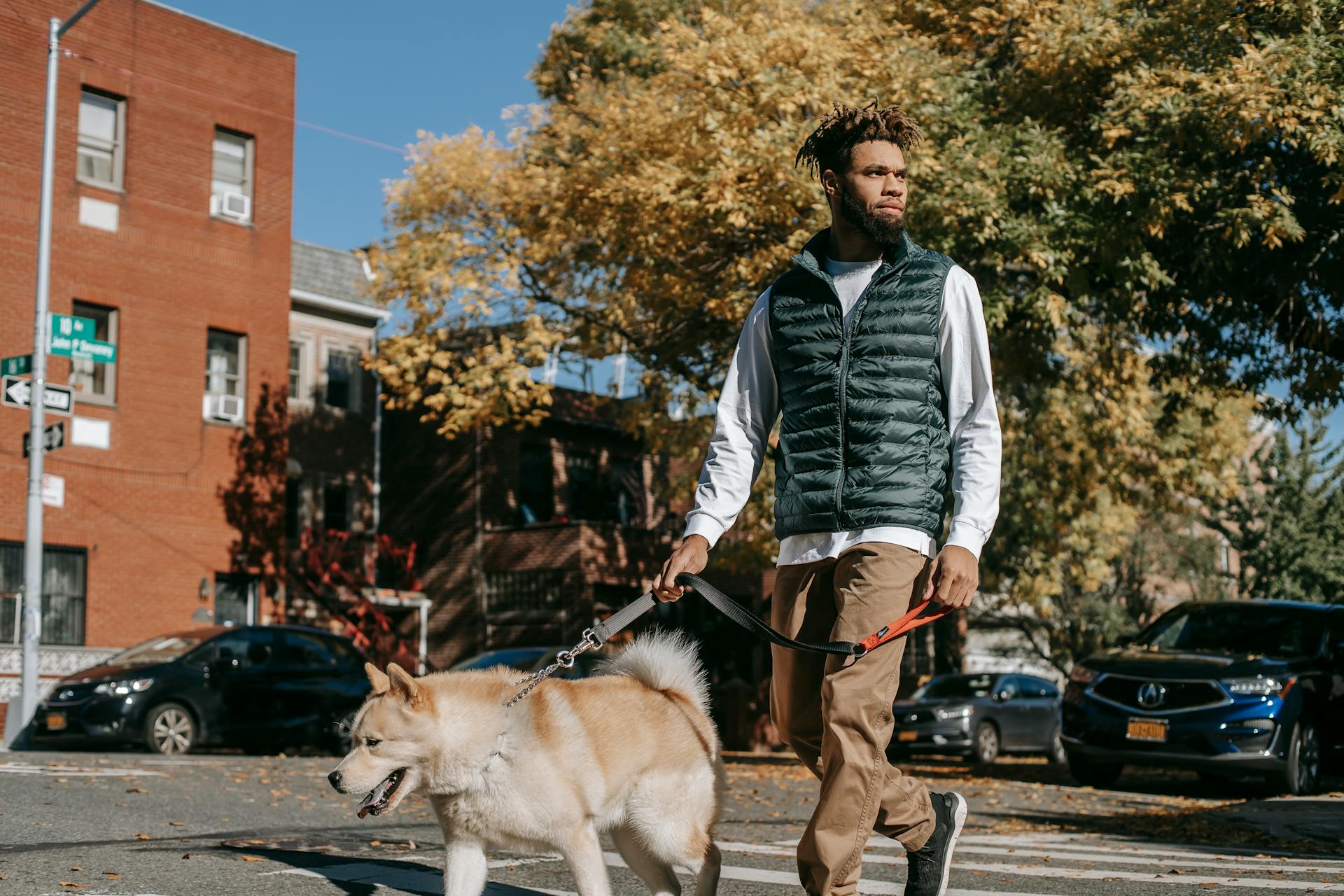
Owning an American Akita comes with both initial and ongoing expenses, including the cost of acquiring a purebred Akita, which can range from $1,000 to $2,500, depending on the breeder and lineage.
To ensure your Akita gets the right amount of food, it's essential to consider their size, age, build, metabolism, and activity level. The recommended daily amount is 3 to 5 cups of high-quality dry food a day.
Their thick double coat requires regular brushing and occasional professional grooming. This can add to the maintenance costs, which include high-quality food, veterinary care, and training.
A high-quality diet is crucial for your Akita's health and vitality. This includes high-quality proteins like chicken, beef, fish, and lamb, as well as healthy fats, fibers, vitamins, and minerals.
Here are some essential feeding guidelines for your American Akita:
As your puppy ages, you can lower the number of times you feed them from 3-4 to twice daily. It's also essential to choose organic puppy food that's specifically formulated for puppies, as it provides a wider range of vitamins and supports bone health.
A balanced diet should include a mix of high-quality dry foods and fresh foods. The best amount to go off is 1 gram of protein per pound of the American Akita's weight.
Care
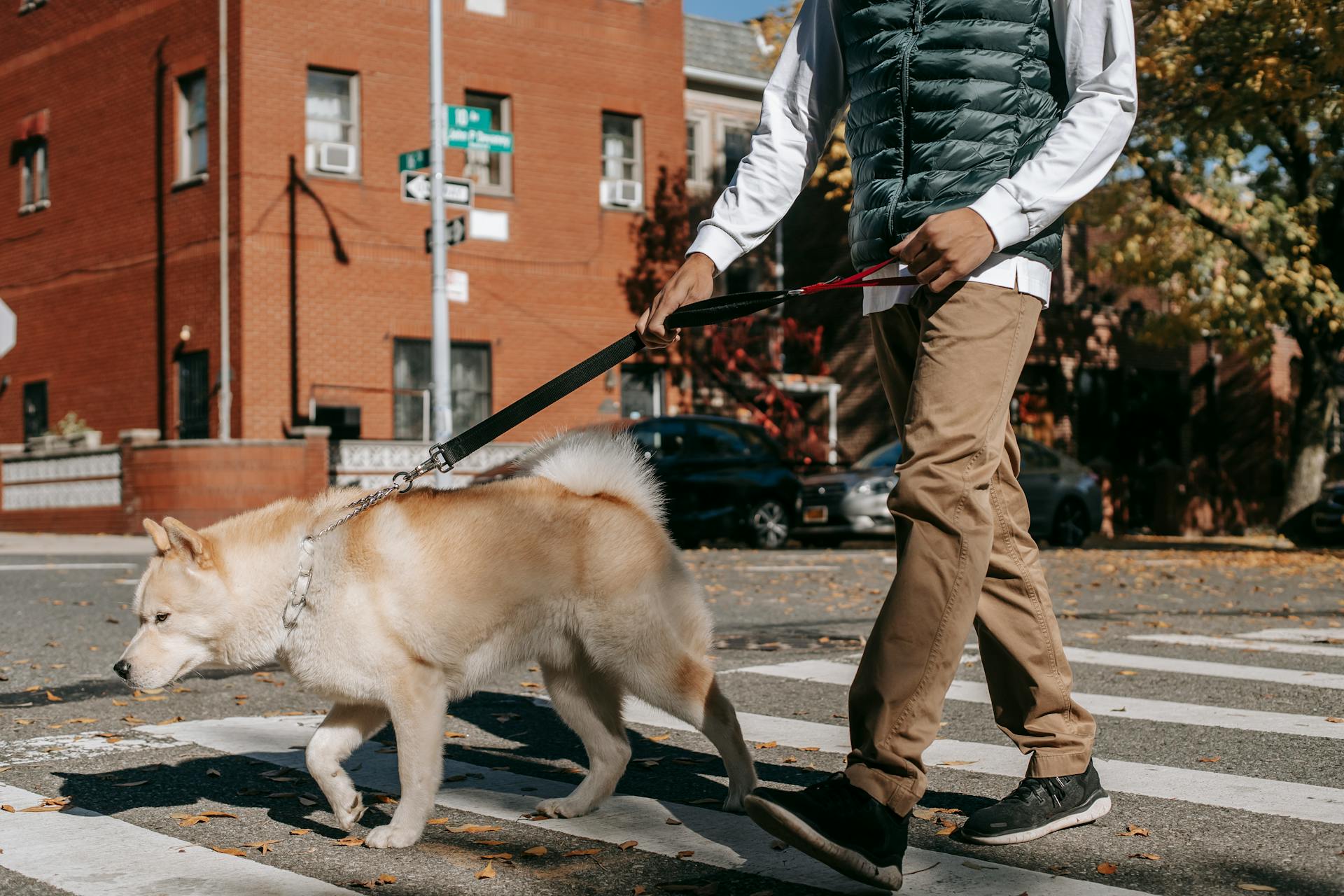
As an Akita owner, you want to ensure your furry friend grows into a strong and healthy adult. Feeding your Akita puppy the right amount of food is crucial, especially during the first year. Start with 200 grams of food per day for puppies up to 3 months, and adjust to 250 grams for 4-5 month-olds.
To support your puppy's metabolism, energy levels, and development, feed them up to four times a day. As they grow, you can lower the number of feedings from 3-4 to twice daily. It's essential to continue feeding your Akita puppy food until they're at least one year old to reap the benefits of added nutrients.
Akita puppies grow rapidly, and their weight changes significantly as they mature. Here's a rough estimate of their weight progression:
American Akitas typically reach their full physical maturity around 18 to 24 months of age. During this period, they'll continue to fill out and gain their powerful physique.
Compare Pet Insurance Plans
When choosing a pet insurance plan, consider the age of your pet. Puppies and kittens typically require more frequent veterinary visits than older pets, so a plan that covers more frequent visits may be a better option.
Some pet insurance plans offer a waiting period for pre-existing conditions, which can be a major concern for pet owners who have already noticed health issues in their pets. This waiting period can range from 2 to 14 days.
Accidents are a common reason for pet insurance claims, and many plans offer coverage for accidents. According to our research, 75% of pet insurance claims are for accidents.
Preventative care, such as vaccinations and dental cleanings, is also an important aspect of pet care. Some pet insurance plans offer coverage for preventative care, which can help pet owners stay on top of their pet's health needs.
The cost of pet insurance can vary greatly depending on the plan and the pet's age and health. On average, pet owners pay between $20 and $50 per month for pet insurance.
Training and Socialization
Training and socialization are crucial for an American Akita puppy. The socialization period, spanning from 4 to 12 weeks of age, is a critical window for shaping their future personality and behavior.
Positive interactions during this time can help prevent fearfulness and aggression, laying the foundation for a well-adjusted, sociable adult dog. This is achieved by introducing your puppy to diverse people, environments, friendly pets, and everyday sounds in a safe and controlled manner.
Key points for socialization include diverse experiences, positive reinforcement, safe settings, and observation and patience. Diverse experiences involve introducing your puppy to different types of people, environments, friendly pets, and everyday sounds. Positive reinforcement uses treats, praise, and play to make new experiences enjoyable and stress-free for your puppy.
To ensure a well-behaved adult Akita, it's essential to socialize your puppy from a very young age. You can start by introducing your puppy to your friends and other dogs one at a time in controlled environments. They may act out when meeting many dogs at once.
Here are some key tips for socialization:
- Diverse Experiences: Introduce your puppy to different types of people, environments, friendly pets, and everyday sounds.
- Positive Reinforcement: Use treats, praise, and play to make new experiences enjoyable and stress-free for your puppy.
- Safe Settings: Ensure all socialization experiences are in safe, controlled settings, especially before completing their vaccination schedule.
- Observation and Patience: Pay close attention to your puppy’s responses. If they seem overwhelmed, take a step back and proceed at a pace comfortable for them.
Training through play and positive reinforcement is recommended for American Akitas, as they respond best to gentle and respectful methods. A harsh approach can make them aggressive. Consistent training from an early age is also essential, as they can easily become bored with it but thrive when challenged and given jobs to do.
Take a look at this: How to Potty Train Maltese Dogs
Family and Living
The American Akita puppy is a wonderful addition to any family, but it's essential to remember that it requires proper training and socialization from an early age.
Its protective and loyal temperament makes it a great companion for children, but it's crucial to supervise interactions to prevent accidents and teach children how to interact properly with a dog of this size and nature.
The Akita can be adaptable to living both outdoors in a large yard and indoors with its family, but apartment living is less suitable, especially if it's often left alone.
It needs regular exercise to prevent weight gain and maintain its physical fitness, making it a great reason to get your family moving and active together.
Supervising interactions between dogs and kids is always a good idea, and this is especially true with this breed, as an Akita can become a loyal guardian and playmate but also a liability if mistreated.
They can be aggressive toward other dogs and may chase other pets if not trained properly, so it's best to have them in a one-pet household.
Children and Pets
If you're considering bringing an American Akita into your family, it's essential to think about how it will interact with your children and other pets. The Akita can be an excellent family dog with proper training and socialization from an early age.
Adults should always supervise interactions between dogs and kids, especially with an Akita, to prevent accidents and teach children how to interact properly with a dog of this size and nature. This breed can be a loyal guardian and playmate for your kids, but it's crucial to teach youngsters to be respectful and kind in all their interactions with dogs.
A fresh viewpoint: Are Akitas Good with Kids
The Akita can get along with dogs of the opposite sex if socialized properly, but they often have trouble with dogs of the same sex. They should also be kept away from small pets like cats since they are driven to chase and hunt prey.
It's not recommended to have multiple Akitas, especially of the same sex, unless you're prepared to provide separate living arrangements and training for each dog. However, getting two opposite-sex Akitas can be a good option if you're set on having multiple Akitas in your household.
Living Conditions
The American Akita is an adaptable dog that can live both outdoors in a large yard and indoors with its family.
However, apartment living is less suitable, especially if it's often left alone. Regular exercise is a must to prevent weight gain and maintain its physical fitness.
Breed Information
American Akitas are a relatively rare breed, originating from Japan where they were bred as hunting companions and guard dogs.
They typically weigh between 70-130 pounds and stand between 24-28 inches tall.
Akitas are known for their loyalty and protective nature, but they can be wary of strangers and may require time to warm up to new people.
Origins and History
The American Akita's origins are deeply rooted in Japan, where its ancestors lived in the Akita region on Honshu Island.
These early dogs were often used as fighting dogs, which led to them being crossed with Mastiffs and Tosas to increase their size and power.
The practice of dog fighting was banned in 1908, but the breed's population continued to decline due to Japanese military requisitions during World War II.
The breed's history is intertwined with its Japanese origins, with the Akita Inu serving various roles, including hunting large game and guarding royalty.
The Akita Inu was revered for its noble characteristics and was eventually designated a natural monument in Japan.
In the United States, the breed's development took a distinctive turn, with breeders emphasizing size and strength, leading to the creation of the American Akita.
The American Akita Club was established in 1972 to promote and protect the breed, solidifying its presence and recognition in the United States.
The breed is part of the Spitz family and has a long and interesting past due to breeding, controversial use, and its introduction to North America.
Discover more: Akita Shiba Inu
Breed Traits
The American Akita is a powerful Spitz breed with a massive build and a sturdy stance. They have solid muscular bodies covered with a double coat that's short and lush.
Their skin is pliant, not loose, and they have a dense and fine underlying hair. The overlying hair is straight, coarse, and harsh.
Akitas have some long hair, but it's only found on their tail. Their hair becomes slightly longer towards the lower end of their neck, stomach, and hindquarters.
Their muzzle is slightly tapered with a black nose, strong deep jawline, and thin black lips. Their necks are thick, medium-length, and muscular.
Akitas have cat-like feet with hard pads, plenty of fur, and are knuckled up. Their toes are also webbed, which helps them walk on the snow by distributing their weight evenly.
They have dewclaws that can be used as ice picks to help them commute in frozen terrains.
Related reading: Wire Hair Dachshund Puppy
Breed Organizations
The American Akita's breed classification was discussed among many organizations before it was finalized. The Japanese Kennel Club played a crucial role in this process.
The Japanese Kennel Club is responsible for submitting the formal proposal to FCI for a breed split between the Japanese and American Akita dog breeds.
The Akita Club of America is the only National Akita Breed Club, and it's a great resource to learn more about the history of the Akita breeds.
The American Kennel Club is also a notable organization that can provide information on the American Akita breed.
Here are some notable breed organizations to check out:
- Akita Club of America
- American Kennel Club
Frequently Asked Questions
How much is an American Akita puppy?
The cost of an American Akita puppy from a reputable breeder is typically between $1,000 and $3,000. This price range may vary depending on factors such as bloodline, health clearances, and breeder reputation.
Is American Akita a good family dog?
Yes, American Akitas are known for their loyal and loving nature, making them a great fit for families who want a strong and devoted companion. However, their high prey drive and strong instincts require careful training and socialization from an early age.
How long do American akitas live?
American Akitas typically live between 10 to 14 years, making them a long-lived breed. With proper care, your Akita can enjoy a long and healthy life.
How big do American Akitas get?
American Akitas typically reach a height of 24-28 inches (61-71 cm) and weigh between 70-130 pounds (32-59 kg). Males are generally larger than females, with a more significant size range.
Can American Akitas be white?
Yes, American Akitas can be white, as they have a dense coat that comes in several colors, including white. Their coat color is one of the many interesting characteristics of this breed.
Featured Images: pexels.com
